Determination of calorie content of food
Calorie content of dishes is a quantitative designation of the energy obtained from the absorption of certain food. Scientists have been experimentally calculating this value for many years, burning food in a calorimeter and recording the values of the heat it generates. Separately, the physiological value of the dish is calculated by measuring the heat generated by the test subject. The results are then translated into the physiological value of the dish (“calories burned”). It is always less, since the human body is not capable of absolute oxidation. Fats and carbohydrates determine the energy value of a dish.
How is food value determined?
Nutritional, or physiological, value is a concept that implies the degree of balance in food of essential nutrients in dishes: vitamins, unsaturated fatty acids, minerals, essential amino acids. The optimal nutritional value of the product implies a ratio of organic substances (proteins: fats: carbohydrates) close to 1:1.2:4, in grams this ratio looks like this: 85:102:360 g. Nutritional value also involves calculating the percentage of vitamins and minerals contained in food from the daily requirement for the human body. Summarizing the data obtained, experts make a conclusion about the usefulness of a particular food product or dish.
The energy value of a dish is understood as the amount of energy released during the oxidation of food particles and used to nourish the cells of the body. As a rule, the energy value is calculated per 100 grams of a dish and the resulting calculation value is expressed in kcal or kJ (1 kcal = 4.184 kJ). Thus, 100 gr. Protein provides 4 kcal of energy, carbohydrates - 4 kcal, and fat - 9 kcal. When a person enters the body with food, organic acids receive 3 kcal for every 100 grams, di- and polysaccharides - 3.8 kcal, ethyl alcohol - 7 kcal.
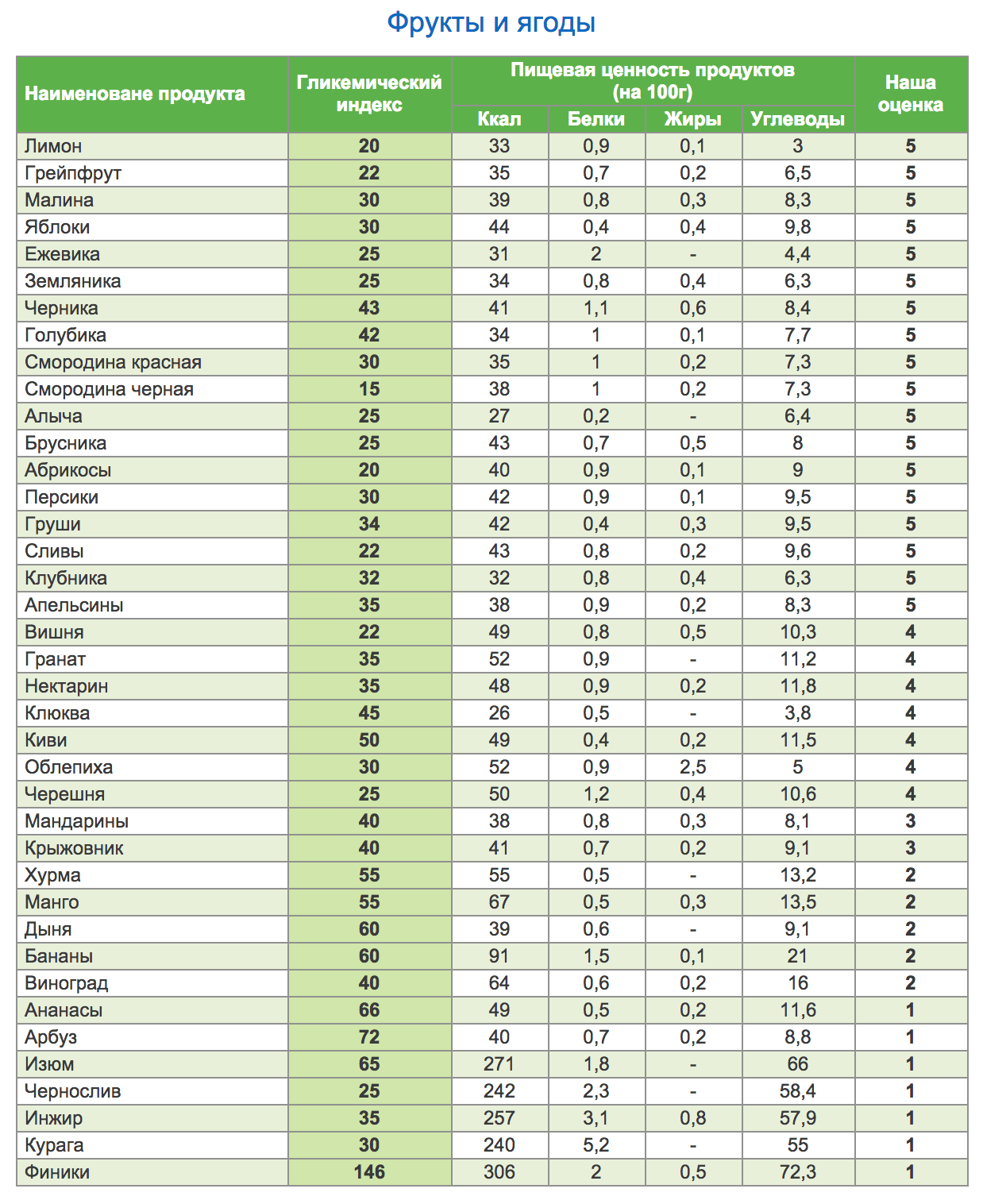
Is it really necessary to count kilocalories and kilojoules?
Many people who want to lose weight begin the fight against extra pounds by counting kilocalories or kilojoules. However, as the results of recent research conducted by the Association of Dietitians of the World in the field of nutrition and health show, most ordinary consumers do not understand this method ( how it works and where to use it
). The organizers of these studies concluded that obese patients need to be taught how to count calories in order to maintain a normal weight.
A survey conducted among the public shows that while some people are becoming fanatical about this idea and counting every kilojoule to hundredths and thousandths, another part of the population does not even try to do this. Such people are very skeptical about this idea. But the best modern nutritionists still adhere to the opinion that counting kilocalories and kilojoules may be the most effective method of weight control.
Although there are other methods that are successfully used by patients to combat extra pounds. For example, the following strategy may be very effective for some people. A patient who is losing weight should be explained that if he reduces food portions, then the amount of excess fat entering the body will correspondingly decrease. You can see for yourself that an individual approach to this issue is of great importance. After all, what is suitable for some is often not acceptable for other people.
Conclusion:
Kilocalories and kilojoules are not a secret, but ordinary units that are successfully used to calculate the energy entering the body and the energy released from it in the process of life.
All representatives of the fair sex who meticulously monitor their figure are familiar with the word - calorie. Of course, even those who did not burden themselves with diets also heard about this. Both of them try to avoid high-calorie foods, as they understand that they are the culprits of excess weight.
Calorie, translated from Latin, means heat. What is calorie content? This is an indicator of the energy contained in food. Moreover, it is determined by the presence of unoxidized carbon and hydrogen atoms in the products.
Fat molecules contain the most of these atoms. Therefore, they are considered very high in calories, so - one gram of lipids has 9.3 kcal, in carbohydrates and proteins, the same - 4.1 kcal. Those who are accustomed to taking care of their health always try to comply with daily calorie requirements and not exceed them.
What determines the daily calorie intake? Of course, first of all, it depends on the type of human activity, age and gender, and so on. So, a growing organism, as it gets older, needs more and more of them for the full development of the body.
But, after reaching maturity, the calorie content of the diet must be revised downwards. The older a person gets, the less energy he needs, with the exception of those who lead an active sports life. During pregnancy and during feeding, the energy component is adjusted upward.
Special tables have been developed indicating how many calories a person consumes during any activity; I will give one of them, in which I will indicate how many kcal. spent per hour of training:
Regular stair climb - 700; Jogging - 500; Ski walking - 500; Race walking - 480; Cycling - from 250 to 450; Swimming - from 250 to 400; Playing tennis and aerobics - 400; Basketball - 300; Work on a summer cottage - 120; Dancing - from 120 to 250; Kitchen work - 85.
Calorie content depends on the chemical composition of the products. For example, foods containing a large amount of fat have the greatest energy potential, which include: butter, vegetable and ghee, mayonnaise, fatty meat products, chocolate.
For example, one hundred grams of lean veal and 1 kg of bananas contain the same amount - about 90 Kcal, and fatty pork - 340 Kcal. The calorie content is also affected by the content of dietary fiber in food products, and the more there is, the lower their energy component. Fiber actively prevents the absorption of fats and carbohydrates.
To determine the calorie content of any product, it is subjected to chemical analysis, thereby finding out how much protein, fat, carbohydrates and other substances it contains, and calculating the total amount. For example, one hundred grams of cauliflower contains 90 grams of water, 4.5 g of carbohydrates and 0.9 g of fiber. Its energy value is 30 kcal per 100 g.
Based on energy value, all food products should be divided into groups
:
Very low-calorie foods These are those foods that contain less than 30 kcal per hundred grams. For example, these include: zucchini, cabbage, cucumbers, mushrooms, radishes, pumpkin, turnips, lettuce, tomatoes, bell peppers.
Low-calorie foods As a rule, they contain from 30 to 100 kcal per hundred grams. For example, milk, kefir, low-fat cottage cheese, yogurt 1.5%, kumiss. Fish representatives include cod, hake, pike, carp, pike perch, and flounder. From fruits and vegetables: radish, green peas, rutabaga, beets, beans, cabbage, potatoes, carrots.
Medium-calorie These are those representatives that contain from 100 to 199 kcal per hundred grams of their weight. For example, lamb and beef of the second category, turkey, horse meat, rabbit meat, chickens, chicken and quail eggs. From fish: asp, sturgeon, mackerel, lean herring, mackerel, horse mackerel, and other species. As well as low-fat cottage cheese and 6% yogurt.
High-calorie One hundred grams of these products contain from 200 to 449 kcal. For example, pork, lamb, sausages, both boiled and semi-smoked, goose. Hard and processed cheeses, sour cream, cheese curds, fatty cottage cheese. From fish: capelin, saury, Pacific herring, caviar. Bakery products, pasta, honey, jam, sugar.
Very high-calorie In one hundred grams of them, from 450 to 900 kcal. For example, all types of oils, lard, lard, fatty pork, raw smoked sausages, nuts, chocolate.
You should know that the human body is individual; accordingly, thin people try to eat fattier foods, but do not gain weight. And overweight people seem to eat moderately, but at the same time they gain weight. It all depends on the metabolism of each individual.
The amount of energy received by the body depends on the degree of digestibility of food, as well as on the state of the digestive system, on the intestinal microflora, and even, to some extent, on the person’s mood. For example, hungry and well-fed people will receive different amounts of energy from one dish, since they will absorb it differently.
After all, a hungry person eats with appetite, and he utilizes everything well. When he is full and eats, he carefully stuffs food into himself. In this case, it is difficult to predict how much energy the body will receive from the food eaten, even if you count its calories.
The biosynthesis of enzymes during the digestion process also requires energy. Moreover, this process accounts for a large share of energy costs. In other words, part of the calories received from food is used to digest and utilize nutrients, approximately 15% of the total calorie intake.
Conclusion
When thinking about your diet, do not forget to take into account the number of calories. Food must be balanced and contain the required amount of fats, proteins and carbohydrates. Watch what you eat, and then you will be slim and healthy!
Nowadays, it is rare that a person does not think about the calorie content of food. This is due to the desire of most modern people to lead a healthy lifestyle and maintain youth and health for as long as possible. The basis of this lifestyle is the organization of proper nutrition, taking into account the calorie content of foods. You need to understand what the calorie content of foods means and why you need to strictly monitor the energy value of your daily menu.
Calorie requirements for different types of work
It has been proven that the more physically active a person is, the more calories his body requires. Accordingly, experts have developed standards for people with different physical loads, but such calculations are characterized by average indicators.
- 2250-2500 kcal is required for workers with intellectual work (designer, programmer);
- 2650-2800 kcal is needed for people with sedentary work (architect, seamstress);
- 3000-3150 kcal is necessary for persons with moderate physical activity and cardio exercise, lifting light objects (teacher, police officer);
- 3500 kcal or more is required for intense physical activity (fitness trainer, amateur sports, painter);
- More than 4000 kcal is needed for workers of heavy physical labor (locksmith, loaders, general workers, professional sports);
- Over 5000 kcal is required when working under life-threatening working conditions (lack of oxygen, high atmospheric pressure). These are workers in industrial mines, specialties associated with long stays in the mountains.
Product groups
Of course, it is better to independently calculate the calorie content of your diet yourself or using a calculator. However, for those who have difficulty in calculations, there is an alternative - groups of dishes. Dividing food into groups allows you to choose the most beneficial dishes for the body; you just need to follow a certain group.
- Meals that promote fat burning enhance metabolic processes and promote the destruction of fat cells. The main condition for them is the low content of fats and carbohydrates, which are quickly absorbed. The list of foods that help burn fat includes: nuts, raspberries, green tea, ginger, pineapple, spices. It is believed that weight loss products include citrus fruits (lemon, orange, tangerine, pamelo, grapefruit).
- Meals that support body weight provide the body with energy without the risk of putting on extra pounds. The list of such foods includes: eggs, porridge from various cereals, vegetables, dietary meats, fermented milk products (cottage cheese, kefir, yogurt).
- Weight-gaining foods are essential for people with a low body mass index. The list of such dishes includes: sweet drinks, fast foods, confectionery and bakery products. This group includes any dishes containing carbohydrates that are quickly digested and yeast. By consuming such dishes, a person receives excess carbohydrates, which are converted into fats and stored. If a person wants to increase muscle mass, then sports and meals rich in protein will be beneficial.
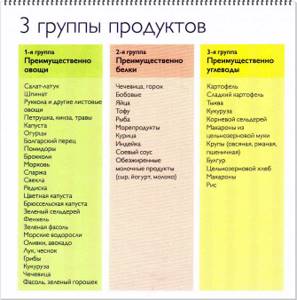
The most popular products are weight loss products. Any diet, including low-carb diets, should include the required amount of water. The calorie content of water is 0 kcal. However, it is important to understand that the human body contains about 70-80% of it, which means it is necessary to maintain health.
Table of calorie content of foods and its meaning
To independently calculate the calorie content of food, you should use special tables. Most often, they indicate not only the energy value of an individual dish, but also its nutrient content (proteins, fats, carbohydrates); such a table is considered the most complete. It is important to take into account that all table indicators are calculated for 100 grams. dishes. For the convenience of calculating the energy value of food, today you can find on the Internet a food calorie analyzer that will do the calculation online.
This counter for calculating calories for weight loss will make the task much easier. Based on the calorie content of 100 grams of various food products included in the calculator, everyone can accurately and quickly calculate the energy value of their daily menu.

What are “calories”?
As you probably noticed, the word “calories” is written in quotation marks, and this is not an accident. The reason is that using the term in this way is not entirely correct, and there are two explanations for this:
- First, many countries traditionally use the metric system of weights and measures ( e.g. kilogram, kilometer and kilojoule
). The term "calorie" is not a metric unit. It is used to measure how many calories we burn each day and the energy content of the food and drinks we consume daily. - Secondly, “calories” can be of two varieties - small calories and large calories, which are designated as follows: 1 kilocalorie or 1 kcal. When experts talk about the energy value of food and the energy that is released during physical activity, they mean kilocalories, that is, large calories.
To avoid confusion, let's try to think of kilocalories ( abbreviated as 1 kcal
) as a non-metric unit of measurement.
It is well known that most readers think and talk about calories, not kilocalories. But adhering to the correct scientific views, it should be noted that in the field of Dietetics and Nutrition Sciences, kilocalorie ( 1 kcal
) is not a metric unit of measurement. Kilocalories are more often used in Western countries. A calorie by definition means the amount of thermal energy required to raise the temperature of 1 ml of water by one degree at an air temperature of 15 degrees.
When it comes to calculating the amount of energy that is contained in food or that we burn during physical activity, ordinary people tend to talk about very large numbers. For these reasons, scientists developed the concept of the kilocalorie. Each kilocalorie is equal to 1000 calories, so this unit of measurement is actually larger than a calorie.
Inconsistency in caloric content of foods
Sometimes you can observe some discrepancy in the number of calories per 100 grams. the same product in different tables. Products of animal and plant origin are obtained from raw materials grown in different climatic conditions. This means that the same food can have a different chemical composition and ratio of nutrients (fats: carbohydrates: proteins). Scientists have proven that the higher the harvest, the less caloric each unit is.
It is worth paying attention to products that are most often subject to erroneous assessment of calorie content and their benefits for a person losing weight.
Cereals and their value
Porridges from various cereals occupy a large share of the daily menu. When following a diet, many people wonder whether it is possible to eat cereal dishes. Cereals have a fairly high calorie content. However, at the same time, cereals are a natural source of carbohydrates, which are absorbed slowly and gradually, and are also a resource for the formation of energy. Only fast carbohydrates (sweets, baked goods) are harmful to the figure. There are no fats in cereals. Cereal dishes are very beneficial for the body. No matter how much cereal porridge is eaten, the carbohydrates contained in it are converted into energy without having time to be deposited in fat reserves. When consuming ready-made cereals, the calorie content is 100 g. product is 2-3 times lower than dry cereals. Cereal dishes should definitely be on the menu of a person who is losing weight.
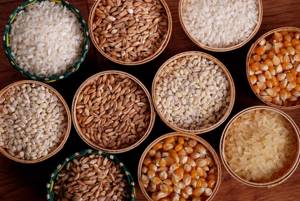
Dried fruits and their value
One of the most delicious and healthy products is dried fruits (drying). Fans of dried fruits, noticing their high calorie content in the tables, refuse to eat them. However, it is not right to refuse drying. Dried fruits contain a concentrate of useful minerals and vitamins that were contained in fresh fruits before drying. It is difficult to imagine that a person would eat a kilogram of dried fruits in a day, but it is quite possible to eat fresh fruits. However, the amount of useful substances entering the body when eating dry food will be much greater.
High calorie content does not mean that drying is harmful for a beautiful figure. Dried fruits perfectly satisfy hunger, which means that a person gets full quite quickly. This product is an excellent alternative to sweets that contain fast carbohydrates. True, it is also not worth using drying in large quantities uncontrollably. You can cook compotes from ready-dried fruits. Due to the fact that the calorie content of water is 0 kcal, compote also contains significantly fewer calories than drying (especially if you add less sugar). Boiled dried fruits are also quite healthy, especially if they are not overcooked (boiling for 10-15 minutes).
Nuts also have a high calorie content. But their value for the body is just as high. In addition, nuts break down fats. You shouldn’t get too carried away with them on a low-carb diet.
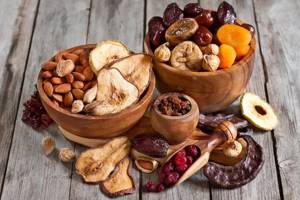
Determination of calorie content of finished products
In order to correctly calculate the calorie content of ready-made dishes, it is necessary to take into account the change in the calorie content of products with different methods of cooking. Correctly calculating the calorie content of finished products will help you correctly adjust your diet. The change in calorie content occurs due to the decomposition of fats, proteins and carbohydrates into their constituent components when heated, as well as the melting of fat from the food product and its evaporation with water vapor. During the cooking process, a huge amount of minerals and vitamins are lost.
When calculating the calorie content of foods, it is necessary to take into account the mass of the finished dish and the total amount of water used to prepare the dish.
So, to determine the calorie content of a finished dish, you need to add up the amount of energy in all the components needed to prepare this dish, and then divide the resulting number by the number of servings. To count calories in pasta and cereals, you need to understand that the calorie content of products after cooking will be three to four times less than in their raw form.
After heat treatment, the weight of many products is noticeably reduced. Weight loss is mainly due to water loss. For example, beef loses about 50% of its water when cooked. When frying, the weight of potatoes decreases by 30-60% (depending on the frying and chopping methods).
Drying berries, crackers or fruits reduces their volume several times. Therefore, the calorie content of finished products will be significantly higher than before cooking. To correctly calculate the calorie content of dried foods, you need to find out how many times their weight decreased after drying, and then multiply the table value indicated in the table of calorie content of products by the resulting number.
Nutritional value of vegetables
When following a diet, preference in nutrition should be given to fruits and vegetables in any form, since their calorie content is minimal and there are no fats. The most interesting among vegetables is cucumber. Of interest is the fact that, despite the low calorie content per 100 g. cucumbers, their satiety is quite high. This is explained by the fact that cucumbers are rich in fiber, and it quickly saturates the body. In addition, cucumber has a high water content. Cucumber also contains a unique substance – tartronic acid. It can inhibit the natural process of converting carbohydrates into fat tissue. This effect is especially appreciated when creating a dietary regimen. Many diets include fasting days, which involve eating only cucumbers during the day. Any low-carb diet includes this food product in the list of recommended dishes. Salads made from fresh cucumbers, tomatoes, cabbage or other vegetables must be on the daily menu, and calorie content can be easily calculated if you use an online calculator.

What is "kJ"?
As mentioned above, in our country all measurement systems are exclusively metric. Thus, we have finally come to the truth that the very energy that nutrients carry and that we spend when playing sports is measured in units called kilojoules or kJ for short. "Joule" ( a small unit of measurement
) is defined as the amount of energy required to move the point of application of a force of 1 Newton to cover a distance of 1 meter.
A kilojoule ( kJ
) or "large joule" is equal to 1000 joules. Ultimately, it is important to remember that the energy we are trying to calculate when planning a diet and planning physical activity throughout the day is measured in kilocalories or kilojoules, that is, in non-metric or metric units of measurement. It is necessary to take into account the difference between these terms.
Nutritional value of omelet
Omelette is considered one of the most complete and healthy breakfasts. Many diets involve eating an omelet for breakfast. However, it is a mistake to believe that the calorie content of an omelet is always low. Each omelet may contain a different number of calories, depending on the additives that are included in its composition. A classic omelette made from a couple of eggs contains only 118 kcal per 100 grams of dish. However, an omelette with cheese has as much as 340 kcal per 100 grams. An online calculator will make it much easier to calculate the calorie content of an omelet. You can also eat omelette on a low-carb diet, but you need to take into account that the additives must be appropriate. To prepare a diet omelette, you can add vegetables and some spices to it. Omelette is an excellent breakfast for any diet.

Rules for healthy eating from nutritionists
Dietitians have long developed and offered healthy eating rules to everyone. Here are some of them:
- daily calorie consumption is equal to (or may be slightly less than) their consumption;
- food should be varied and balanced, using all food groups;
- high-calorie foods are consumed in the first half of the day, and light foods in the evening;
- only fresh and natural food is used;
- you should limit or completely eliminate the consumption of junk food: sweets, flour products, mayonnaise, etc.;
- you need to use the correct methods of processing food; food remains healthy when boiled, stewed, baked;
- Drinking clean water should be sufficiently abundant;
- The diet also matters, it should be fractional, that is, 5-6 times a day in small portions.
By constantly counting how many calories are in your plate, you can get great results.
Switching to proper nutrition reduces the risk of developing many deadly diseases, slows down the aging process, improves mood and a positive outlook on life. The benefits of a healthy diet for the human body can be listed endlessly.
Dairy products
Fermented milk products are very beneficial for the human body. The lowest calorie of them is kefir. Kefir is quite often included in the menu of many diets. There are even mono-diets that involve consuming kefir for 1-3 days. The kefir diet is quite effective and healthy; it allows you to lose 1.5-2 kg in a few days. You can not only drink this drink in its pure form, but also prepare various diet cocktails or dishes using kefir (okroshka, porridge). It is a mistake to think that the calorie content of kefir greatly depends on its fat content. 1% kefir contains about 40 kcal per 100 grams, and with a fat content of 3.2% - approximately 60 kcal. In any case, kefir is useful for a person losing weight. Kefir helps burn fat and normalizes the functioning of the digestive tract.
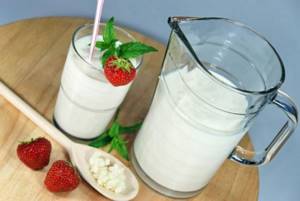
Calorie content of sausage

As already noted, smoked meats contain more calories. So, on average they have 470-570 kilocalories. At the same time, for “varenka” this indicator varies from 170 to 320. Returning to the topic of what contains more calories, milk or sausage, we will look at the table that shows the most popular delicacies.
| Sausage variety | kcal |
| ham | 239 |
| cervelat | 459 |
| dietary | 171 |
| doctorate | 258 |
| liver | 326 |
| amateur | 302 |
| Krakow semi-smoked | 466,3 |
| grainy raw smoked | 607 |
| Moscow raw smoked | 472,8 |
This list is based on 100 g of product.









